The History of Computer Chess Unravelled
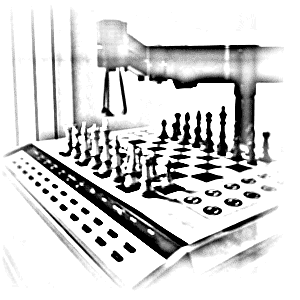
History of Computer Chess
The machine was like a cabinet and had a chess board sitting on top. There was a statue of a Turkish gentleman on one side of the table, the human player would sit on the other side. The human player would play their moves and then the Turk's pieces would move by themselves!
It turned out to be a hoax. The pieces and the board were magnetized and there was a strong human chess player concealed in the machine under the board. He could see where the pieces were being moved by magnets on corresponding squares below. He could control his own pieces by moving his magnets.
Eventually the illusion was uncovered. But the desire to create a chess playing machine was very real. 170 years later it would be realized as the first chess computers were developed during the 1940s. The journey had finally begun. For real this time.
Early Chess Programming

History of Computer Chess - Claude Shannon and Arthur Turing were pivotal figures in the early days of computer chess development
The methods used to develop programs that could find the best moves for any chess position could be implemented in problem solving applications for any conceivable task. Early chess computer pioneers would develop programming techniques that would shape the world of IT so commonplace in our lives today.
The first primitive computers began to emerge as a central plank in human communications in the 1940s. It wasn't long before students and academics began to work on chess programs. The earliest ones could not play a full game. The best they could do was find a checkmate if it was within 2 moves.
Heuristics and Algorithms
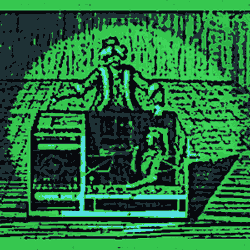
History of Computer Chess - The Turk was the first chess computer
In the 1940s they only had extremely limited memory capabilities. People were still mainly going with the plan of making computers think and rationalize just as people do, only with a greater capacity.
This approach was based on heuristics, recognition of logical patterns. Illogical moves would be discarded immediately and the more promising ones investigated further.
The second choice involves extensive use of algorithms, calculating every conceivable line to the maximum possible depth. By finding the best move through brute force, intuitive play through rational thought was sacrificed in favor of trial and error elimination.
Computer vs Computer Tournaments

History of Computer Chess - Chess Computers competed against each other in tournaments
Plans for computer vs computer chess tournaments were drawn up. Each group worked on their own programs and then tested themselves against each other to see who was stronger. It was at these events that researchers from different places could exchange ideas.
All chess programs grew steadily stronger as the best innovations and ideas were continually modified and finessed and obsolete practices were discarded.
New Ground Breaking Features
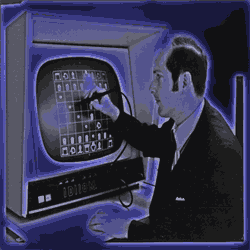
History of Computer Chess - Nasa finished runner-up in the first World Computer Chess Championship in 1970
The openings became the domain of heuristics. Known strongest moves in all opening variations would be loaded into the programs to avoid any need for calculations. This data became known as Opening Books.
Hash Tables were also developed. They contained data on millions of chess positions which had already been analyzed. The data was stored so that the position would not need to be analyzed again.
Endgame Databases worked on a similar logic. Well known endgame positions were analyzed in totality with the data saved. This meant that when these positions were reached in a game, the computer did not have to do any analysis during the game. It would just fire out the moves in the database immediately, playing the endgame perfectly.
Mainstream Chess Software

History of Computer Chess - Chessbase is the industry standard in chess database software
The home computer revolution of the 1980s changed everything. PCs were being developed for the mass market. A new era was dawning. More and more ordinary people had computers in their own homes. Eventually it became commonplace.
This opened up possibilities for a whole new range of products for a whole new market. Software programs of all kinds including the latest and greatest chess programs became available to the consumer.
Now the mass market was ready. More funds than ever before were invested in chess software which was replacing the dedicated chess computer. Soon people were being trained to a good standard by software rather than a human coach. Chess engines were getting stronger and stronger. Now the best ones were good enough to give GMs a run for their money.
Man Against Computer
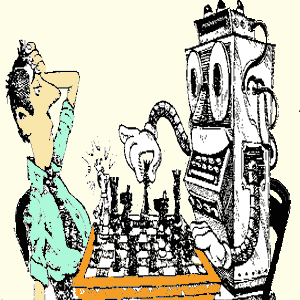
History of Computer Chess - The computers were finally going up against the top human chess GMs
Hitech beat GM Arnold Denker and Chiptest's machine, Deep Thought beat serial World Championship Candidate GM Bent Larsen. Man vs Computer events were held regularly during the 90s with teams of top human players defending humanity's honor against the machines. The humans were winning at first. However slowly but surely the pendulum swung towards the computers.
The big question on everyone's lips was if or when a computer would or could ever win a match against a reigning World Champion. Kasparov smashed Deep Thought +3-1=2 in Philidelphia in 1996. A year later, Deep Thought, since renamed Deep Blue, turned the tables on Kasparov, winning +2-1=3 in New York. This was the biggest event to date in the history of computer chess.
Impact of Computers on Chess
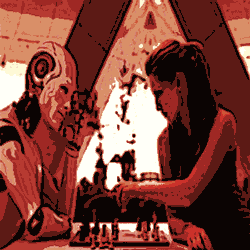
History of Computer Chess - Computers have had a huge impact on chess
It is quite normal for a top GM to set up chess positions using their chess software on a lap top or desk top and leave it there running all week. They then come back to it and check out the strongest variations stemming from the particular moves they were analyzing.
Different variations and lines have been discredited and busted by chess programs that found their flaws and weaknesses. Other lines have been strengthened as the software has found new interesting innovations for old ideas.
Some completely new sequences have been developed. Some well known modern moves don't look at all natural, logical or obvious. They are clearly far too deep for a human to possibly formulate. They were found only through the sheer brute force of computers and they are now part of chess theory.
Silicon Effect on Chess
History of Computer Chess - The computer has changed chess dramatically
Many more people are actually playing the game simply because they now have access to opponents that they did not have before. Online chess has replaced postal chess as the foremost category of correspondence chess.
The sheer volume of very young players who have reached GM level is testament to the training resources made possible by Information Technology. It's possible to reach that standard in just a fraction of the time that was once the case if you put in the work.
Moving On

Battle Chess
Games were going 20-25 moves before getting out of book. People were worried the game was becoming a lifeless scientific knowledge test. And yet for every question answered, numerous new ones are posed. Every time a new great move is found it is merely the first step on a number of new variations. The tree keeps spreading out, sprouting new branches.
Great leaps and bounds in chess theoretical analysis are not the only things that computers have bestowed on chess. Another chess child of the IT era is Battle Chess.






